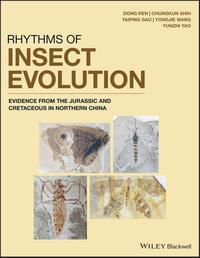254.95
3 - 5 Werkdagen
DISCOVER THE SECRETS AND SILENT STORIES REVEALED BY EXTRAORDINARY INSECT FOSSILS FROM THE MID-MESOZOIC FAUNAS IN NORTHERN CHINA
Rhythms of Insect Evolution: Evidence from the Jurassic and Cretaceous in Northern China showcases 23 different orders of insect fossils from the Middle Jurassic to Early Cretaceous (165 to 125 Ma) that were collected in Northern China. The book exhibits and reports these fascinating insect fossils in brilliant detail, telling their stories with a combination of expert commentary and specially produced photographs, line drawings, and 3-D reconstructions. It covers not only their taxonomy and morphology, but also their potential implications on natural sciences, such as phylogeny, function, interaction, evolution, and ecology. It highlights fossil sites; stratigraphy; co-existing animals and plants in well-balanced eco-systems; insects in the spotlight; morphological evolution and functional development; and interactions of insects with co-existing plants, vertebrates, and other insects. The content of the book includes:
- A combination of academic natural science, popular science, and artistic presentation to illustrate rhythms of evolution for these fossil insects
- Documents of morphology, taxonomy, phylogeny, and evolutionary changes of 23 orders of insects from the Middle Jurassic and Early Cretaceous faunas in Northern China
- Interactions of insects with plants, vertebrates, and other insects based on well-preserved fossil evidence
- Photos of extant insects and plants, fossil and amber specimens, line drawings, and 3-D reconstruction artworks to give readers clear and enjoyable impressions of the scientific findings
- Insect-related stories from Western and Chinese culture in text or sidebars to give global readers broader exposures
Entomologists, evolutionists, paleontologists, paleoecologists, and anyone with an interest in the natural sciences will find Rhythms of Insect Evolution an illuminating and colourful journey through the evolutionary changes of these ancient creatures.
- A combination of academic natural science, popular science, and artistic presentation to illustrate rhythms of evolution for these fossil insects
- Documents of morphology, taxonomy, phylogeny, and evolutionary changes of 23 orders of insects from the Middle Jurassic and Early Cretaceous faunas in Northern China
- Interactions of insects with plants, vertebrates, and other insects based on well-preserved fossil evidence
- Photos of extant insects and plants, fossil and amber specimens, line drawings, and 3-D reconstruction artworks to give readers clear and enjoyable impressions of the scientific findings
- Insect-related stories from Western and Chinese culture in text or sidebars to give global readers broader exposures
Entomologists, evolutionists, paleontologists, paleoecologists, and anyone with an interest in the natural sciences will find Rhythms of Insect Evolution an illuminating and colourful journey through the evolutionary changes of these ancient creatures.

- : John Wiley And Sons LTD
- : John Wiley And Sons LTD
- : 9781119427988
- : Engels
- : Hardcover
- : 728
- : april 2019
- : 2223
- : 277 x 224 x 36 mm.
- : Paleontologie; Stenen, mineralen en fossielen: algemeen
